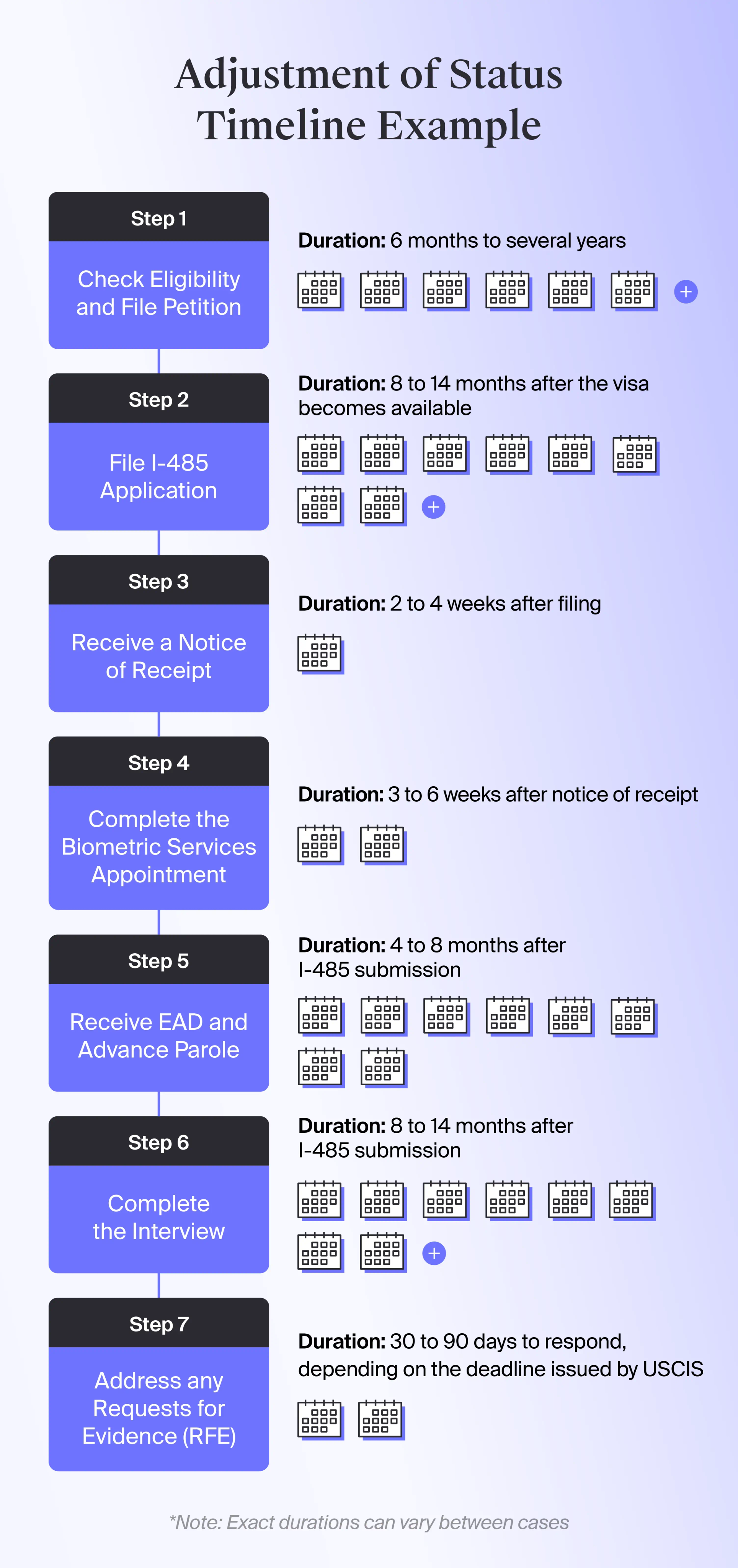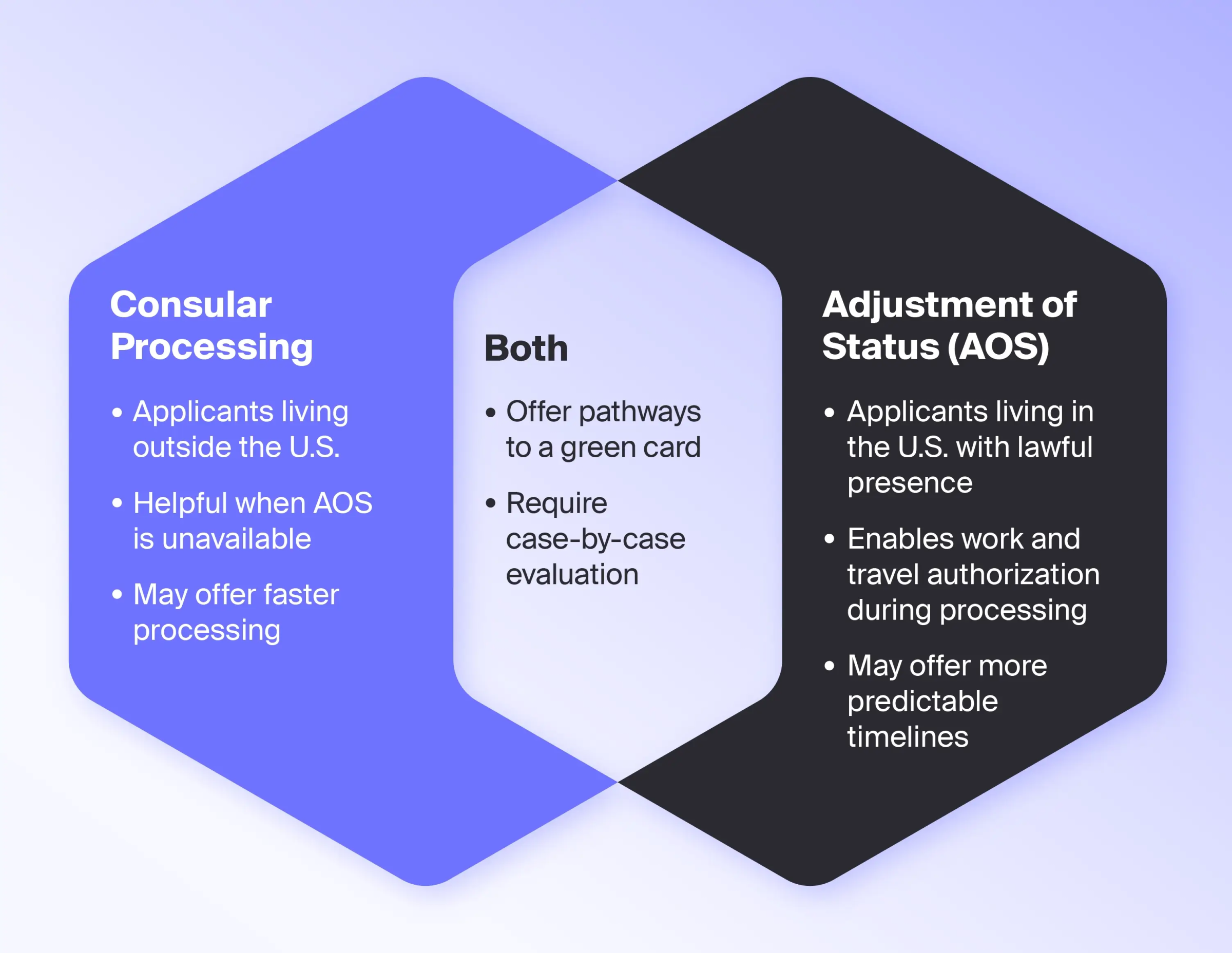Key takeaways
To help your firm set accurate expectations, here’s a breakdown of the adjustment of status timeline with estimated durations for each stage:
Biometric Appointment: 5–8 weeks after filing
Work Permit (EAD) and Advance Parole Approval: 6–8 months
Adjustment of Status Interview: 8–14 months after initial application (varies by field office)
Final Decision (Green Card Approval or Denial): Often follows the interview within 2–4 weeks, though some cases take longer
Adjustment of status (AOS) is when eligible noncitizens already present in the U.S. can apply for lawful permanent resident status without leaving the country for consular processing. For law firms, AOS cases represent both high stakes and long timelines.
Understanding the adjustment of status timeline is important for managing client expectations and internal workflows. While U.S. Citizenship and Immigration Services (USCIS) processing times vary by eligibility category and service center, the basic sequence of steps remains the same.
In this guide, we’ll walk through each phase of the AOS process, provide updated estimates for 2025, and show how law firms can streamline case tracking and communication using MyCase’s immigration features.
Adjustment of Status Timelines for 2025
The USCIS adjustment of status timeline can vary significantly depending on the applicant’s visa category, country of origin, and the service center processing the case. While some green card applicants may receive decisions within eight months, others may wait over a year.
On average, the adjustment of status timeline in 2025 ranges from 10 to 24 months, though this can shift with policy changes, volume, and backlogs.
So, how long does adjustment of status take? It’s safest to tell clients to expect anywhere from 10 to 24 months, depending on their scenario. These are only general benchmarks, so we recommend checking the USCIS processing times page for the most up-to-date estimates.
Employment-Based Adjustment Application
Employment-based AOS cases are most commonly tied to PERM labor certification and I-140 approval. Delays can arise from backlogs in certain categories, changes in employer sponsorship, or retrogression in priority dates. Prepare clients for variable adjustment of status application processing speeds.
The adjustment of status timeline for employment-based cases typically ranges from 12 to 24 months, depending on category, visa bulletin movement, and USCIS service center capacity. While some EB-1 cases move relatively quickly, others, especially EB-3, may face longer wait times.
The employment-based preference categories include:
Type of employment preference | Employment type | Examples |
|---|---|---|
EB-1 | Highly-skilled workers | Multinational executives, outstanding researchers, individuals of extraordinary ability |
EB-2 | Professions requiring advanced degrees, National Interest Waiver | Doctors, lawyers, professors, and engineers; Individuals doing work important to the national interests of the U.S. |
EB-3 | Skilled workers, positions requiring a bachelor’s degree, and other (“unskilled”) workers | Journalists (skilled workers), teachers (need a bachelor’s degree), and farm laborers (other workers) |
EB-4 | Religious workers, armed force members, and international employees | Ministers, broadcasters, and U.S. government employees abroad |
EB-5 | Immigrant investors | Those who create jobs through investments within the U.S. |
As of 2025, the EB2 adjustment of status timeline typically ranges from 14 to 24 months, depending on visa bulletin movement and service center processing speeds. The EB5 adjustment of status timeline tends to be longer, often ranging from 24 to 36 months.
Family-Based Adjustment Application
Most family-based adjustment of status applications take between 12 and 36 months, depending on the relationship and preference category. Immediate relatives of U.S. citizens, such as spouses, unmarried children under 21, and parents, typically see faster timelines, around 12 to 18 months, because the immigrant visa numbers are not limited by statute.
The K-1 visa adjustment of status generally takes 12 to 16 months, depending on local field office backlogs and documentation readiness. The K-2 dependent’s adjustment of status timeline generally mirrors the K-1 process.
Timing is especially sensitive for K-1 and K-2 visa holders who must enter on those specific visas to be eligible. K-1 applicants must marry within 90 days of entry and file Form I-485 promptly; K-2 dependents must follow similar adjustment windows.
Common family-based categories include:
Immediate Relatives: Spouse, child under 21, or parent of a U.S. citizen
FB-1: Unmarried adult sons and daughters of U.S. citizens
FB-2: Spouses and children of lawful permanent residents
FB-3: Married sons and daughters of U.S. citizens
FB-4: Siblings of U.S. citizens
K-1 Visa: Fiancé(e) of a U.S. citizen
K-2 Visa: Child of a K-1 visa holder
The K1 adjustment of status timeline ranges from 12 to 16 months, depending on field office workloads and the completeness of the application package. For U.S. citizen spouses filing Form I-130, the adjustment of status through marriage timeline ranges from 12 to 18 months.
Asylum, Refugee, or Other Humanitarian-Based Adjustment Application
Humanitarian-based adjustment of status applications typically take 12 to 24 months after filing Form I-485, though timelines may be longer depending on background checks, supporting evidence, and the case volume at local field offices.
Unlike employment or family-based applicants, many clients in this category must wait at least one year after receiving their qualifying humanitarian status before applying for adjustment.
These cases often require additional sensitivity and documentation, such as evidence of ongoing eligibility, police clearances, or affidavits in VAWA cases. Law firms should be ready to help clients respond to Requests for Evidence (RFEs) related to hardship, trauma, or eligibility continuity.
Common humanitarian-based categories include:
Asylee Adjustment – INA § 208
Refugee Adjustment – INA § 209
VAWA (based on an approved Form I-360)
U Nonimmigrant Status (victims of certain crimes)
T Nonimmigrant Status (victims of human trafficking)
How To File for Adjustment of Status
Filing for adjustment of status involves multiple steps that unfold over several months, and in some cases, several years. While timelines vary based on the applicant’s eligibility category and country of origin, most cases follow a predictable structure.
In this section, we’ll walk through the process step-by-step and offer time estimates your firm can use to build stronger workflows and set client expectations.
Step 1: Check Eligibility and File Petition
Duration: Six months to several years (depending on category and visa bulletin priority date)
Relevant forms:
Form I-130: Petition for Alien Relative (used in family-based AOS cases)
Form I-140: Immigrant Petition for Alien Worker (used in employment-based cases)
Form I-360: Petition for Amerasian, Widow(er), or Special Immigrant (used in VAWA, religious worker, and other special categories)
Form I-526: Immigrant Petition by Standalone Investor (for EB-5 applicants)
Before filing any AOS form, confirm that the client qualifies to adjust status. In most cases, the client must begin by having a petition filed and approved on their behalf. This can trigger a long adjustment of status wait time, particularly for applicants from lower preference categories.
Once the petition is approved, clients must still wait for their priority date to become current before moving forward with Form I-485. For some applicants, this waiting period is minimal. For others, particularly EB-3 or FB-4 applicants, the AOS timeline at this stage can stretch across several years.
Filing fees also vary by petition type. As of 2025, Form I-130 carries a base fee of $675, while Form I-140 typically costs $715. Some applicants may be eligible for fee waivers or reduced costs, especially in VAWA or humanitarian-based petitions.
Step 2: File I-485 Application
Duration: Eight to 14 months (after visa becomes available)
Relevant forms:
Form I-485: Application to Register Permanent Residence or Adjust Status
Form I-765: Application for Employment Authorization
Form I-131: Application for Travel Document (Advance Parole)
Form G-28: Notice of Entry of Appearance as Attorney or Accredited Representative (if applicable)
Form G-1145: E-Notification of Application/Petition Acceptance (optional but recommended)
Once USCIS approves the underlying petition and a visa number becomes available, your client can submit their adjustment of status application, Form I-485. This is one of the main forms needed for adjustment of status and must be filed while the applicant is still in a lawful U.S. immigration status.
Determining when to file an adjustment of status depends on the monthly visa bulletin, so firms should track cutoff dates carefully to avoid premature or delayed submissions.
In addition to the I-485, clients can file for a work permit (Form I-765) and an advance parole travel document (Form I-131) concurrently. These benefits allow the applicant to work and travel while the I-485 is pending, reducing disruption for both employment and personal mobility.
The base filing fee for Form I-485 as of 2025 is $1,440, though certain categories may qualify for waivers or reduced fees.
Step 3: Receive a Notice of Receipt
Duration: Two to four weeks after filing
Relevant forms:
Form I-797C: Notice of Action (receipt notice used to confirm the application was received and accepted for processing)
Form G-1145: E-Notification of Application/Petition Acceptance (if submitted, triggers email/text updates)
After filing the adjustment of status application, USCIS typically sends an official Notice of Action confirming receipt within a few weeks. This notice, Form I-797C, includes the applicant’s receipt number, which the lawyer can use to track the case status online and confirm automatic work authorization extensions.
Legal professionals should ensure that clients retain this notice and that the mailing address on file with USCIS is accurate and up to date. Delays in receiving the receipt notice may indicate issues with the initial filing, including payment errors, missing signatures, or incorrect form versions.
Step 4: Complete the Biometric Services Appointment
Duration: Three to six weeks after receipt of notice
Relevant forms:
Form I-797C: Appointment notice for biometrics
Form I-485 Supplement A (if required, depending on eligibility grounds or inadmissibility waivers)
Roughly a month after USCIS issues the I-797C, applicants will receive a biometric appointment notice. This appointment typically takes place at a local Application Support Center (ASC) and is mandatory for most green card adjustment of status applicants, unless waived due to age or past biometric data reuse.
There is a biometric services fee associated with this stage, typically $85, unless a waiver was granted, which is paid at the time of filing Form I-485. Missing this appointment without rescheduling can delay the case or trigger denial, so it is important to track these dates and prepare clients for what to expect.
Step 5: Receive EAD and Advance Parole
Duration: Four to eight months after I-485 submission
Relevant forms:
Form I-765: Application for Employment Authorization (EAD)
Form I-131: Application for Travel Document (Advance Parole)
Combo Card: A dual-purpose card issued when Forms I-765 and I-131 are approved together
After the biometric appointment, applicants who filed Forms I-765 and I-131 along with their adjustment of status application can expect to receive their Employment Authorization Document (EAD) and Advance Parole travel card.
Though timing can vary, these approvals typically arrive four to eight months after initial filing. Law firms should advise clients not to travel internationally until they receive Advance Parole, as leaving the U.S. without it may result in abandonment of the AOS application.
Step 6: Complete the Interview
Duration: Eight to 14 months after I-485 submission (though it may vary by field office)
Relevant forms: None typically required at this stage.
USCIS will schedule an in-person interview at a local field office for most applicants. While marriage-based and asylum-related AOS cases almost always involve an interview, some employment-based applicants may receive a waiver.
During the interview, a USCIS officer will verify information from the I-485, assess the authenticity of supporting evidence, and ask additional questions about admissibility or eligibility. Follow-up interviews may be scheduled when more information is needed.
There are typically no new forms or fees required at this stage, unless a previously undisclosed ground of inadmissibility is discovered, which could trigger a waiver request. In most well-managed cases, any required waivers would already have been filed earlier in the process.
Step 7: Address any Requests for Evidence (RFE)
Duration: 30 to 90 days to respond, depending on the deadline issued by USCIS
Relevant forms:
Form I-601: Application for Waiver of Grounds of Inadmissibility (only if newly required during RFE review)
Client supporting documentation: Updated evidence per USCIS request
USCIS may issue a Request for Evidence (RFE) at any point after receiving the adjustment of status application if it finds missing, inconsistent, or unclear information. RFEs are common and case-specific; they may ask for updated financial documentation or clarification on previous filings.
While there are no new filing fees for an RFE response, preparing the response may require collecting updated records or affidavits. In rare cases, if the RFE uncovers a ground of inadmissibility not previously disclosed, your firm may need to file a waiver, which does carry a fee.
Waiver fees may be eligible for reduction or exemption depending on the applicant’s status and financial situation.
Step 8: Receive USCIS Decision
Duration: Two to six weeks after interview or RFE response
Relevant forms: None
After the interview, or once all required documents and responses are received, USCIS will issue a final decision on the applicant’s Form I-485. If approved, the applicant will receive a welcome notice followed by the physical green card, typically within a few weeks.
If the adjustment of status application is denied, USCIS will issue a written notice explaining the reason(s). Depending on the circumstances, applicants may have the option to file a motion to reopen or reconsider with USCIS, appeal the decision (in limited cases—if based on the denial of the underlying petition), or refile with stronger documentation.

Adjustment of Status Requirements
Before beginning the adjustment of status process, ensure that clients meet a core set of eligibility criteria. While specific categories, like employment-based or humanitarian-based cases, may introduce unique considerations, most applicants must satisfy the same requirements.
Here are the general adjustment of status requirements that apply across most categories:
Lawful Entry into the U.S.: The applicant must have entered the U.S. with a valid inspection and admission or parole.
Eligible Immigration Category: Must qualify under a valid immigrant preference category (e.g., EB, FB, asylum, VAWA).
Visa Availability: An immigrant visa number must be available in the category at the time of filing (per the Visa Bulletin).
No Bars to Adjustment: Must not be subject to statutory bars (e.g., unlawful presence, unauthorized work, or criminal history) unless waived.
No Prior Green Card via Fraud or Misrepresentation: Past immigration violations may disqualify the applicant unless waived.
Physically Present in the U.S.: Applicant must be in the U.S. at the time of filing Form I-485.
Medical Exam Completion: Must provide Form I-693 (Report of Medical Examination and Vaccination Record), either at filing or later in the process.
Consular Processing vs. Adjustment of Status
Adjustment of status allows eligible applicants already in the U.S. to apply for a green card without leaving the country. In contrast, consular processing requires attending an interview at a U.S. embassy or consulate abroad.
Choosing between the two depends on factors like physical presence, processing times, travel plans, and the risk of triggering unlawful presence bars. Each path carries trade-offs, and law firms should assess which route offers the safest, most efficient outcome for their client.
Consular processing may be a fit for:
Applicants who are currently living outside the U.S.
Cases where adjustment of status is not available or barred due to unlawful entry
Applicants who want to avoid lengthy USCIS backlogs
Clients with clear immigration histories and no risk of triggering reentry issues
Situations where travel to the U.S. consulate is logistically easier or faster
Adjustment of status may be a fit for:
Applicants who are already in the U.S. with lawful presence
Clients who may face inadmissibility bars if they leave the country
Cases that require work authorization or travel parole during processing
Applicants seeking more predictable timelines and less consular risk
Firms managing complex humanitarian or employment-based AOS applications

Common Factors That Impact Adjustment of Status Timelines
Adjustment of status timelines aren’t one-size-fits-all, and delays can come from more than just USCIS backlogs. A wide range of issues can slow down a case, from priority date retrogression to missing biometrics or document errors.
Navigating Backlogs for Certain Countries
Type of Challenge: External
Visa backlogs are among the most common causes of adjustment delays, especially for applicants from high-demand countries like India, China, Mexico, and the Philippines.
The U.S. immigration system operates under annual per-country limits, which means even fully qualified applicants can wait years for a visa number to become available based on their scenario and country of origin. Retrogression can further complicate planning and delay I-485 filing.
How to Navigate This Challenge:
Law firms should monitor the monthly Visa Bulletin closely and prepare clients for shifting timelines based on their country of chargeability. Consider alternate pathways such as cross-chargeability (through a spouse) or EB-2 national interest waivers.
Use MyCase Immigration to track visa bulletin updates and flag clients approaching critical dates.
Working Through Local Processing Times
Type of Challenge: External
Processing times can vary dramatically depending on the applicant’s assigned USCIS field office. Some offices handle workloads faster than others, even within the same state, creating uneven timelines for biometric appointments, interviews, and final decisions.
Applicants moving between jurisdictions mid-process can also face delays if files are transferred or interviews are rescheduled.
How to Navigate This Challenge: Check local processing estimates using the USCIS Processing Times tool and factor those into client planning. When delays are unavoidable, maintaining consistent communication is essential.
Addressing Nuanced Needs of Various Application Types
Type of Challenge: External
Employment-based AOS cases may involve PERM labor certification and priority date management, while marriage-based filings often center around relationship evidence.
Humanitarian categories like VAWA or asylum require trauma-informed documentation and unique admissibility considerations. Each pathway introduces its own eligibility rules, form requirements, and risks of delay.
How to Navigate This Challenge:
Specialized workflows can help. Use intake questionnaires tailored to each category, and make sure documentation templates account for case-specific evidence requirements. Standardizing complexity at the system level ensures even nuanced cases move forward smoothly.
Adapting to Policy and Regulatory Changes
Type of Challenge: External
Immigration policy is especially vulnerable to administrative shifts, court rulings, and regulatory updates, which can impact AOS eligibility, filing procedures, and adjudication standards.
Changes may roll out quickly, sometimes with limited USCIS guidance, leaving law firms scrambling to adjust documentation, timelines, or even client strategy mid-process.
How to Navigate This Challenge:
Build flexibility into your workflows and stay plugged into trusted legal news sources, AILA updates, and USCIS alerts. MyCase can help your team centralize policy notes, track impacted cases, and adapt checklists or templates in real time.
The right systems allow your firm to respond faster to regulatory changes and maintain client confidence, even when the rules shift midstream.
Tracking Key Deadlines
Type of Challenge: Internal
Adjustment of status cases come with dozens of time-sensitive milestones, biometrics appointments, RFE response deadlines, EAD renewals, interview dates, and more.
With multiple cases in motion, it’s easy for even experienced firms to miss a notification, misfile a receipt notice, or overlook a priority date becoming current.
How to Navigate This Challenge:
Use centralized case management tools to log critical dates, set reminders, and track status changes in one place. This reduces dependency on manual spreadsheets or inbox searches and ensures nothing slips through the cracks.
Managing and Preparing Documents
Type of Challenge: Internal
Adjustment of status applications involve extensive documentation, including tax records, marriage certificates, birth certificates, employer letters, immigration history, and more. Each document must be complete, current, and properly formatted to avoid RFEs or denials.
Juggling these requirements across multiple clients and categories can quickly overwhelm even well-staffed firms, especially when relying on email threads or scattered folders.
How to Navigate This Challenge:
Standardize document checklists for each AOS category and use client portals to collect materials securely. Centralized document management and automation save time and dramatically reduce the risk of omissions or mismatches that lead to processing delays.
Coordinating With Clients
Type of Challenge: Internal
Immigration cases are often deeply personal and high-stakes, making client communication challenging. Applicants may struggle to understand the adjustment of status wait time or provide documents on time, especially when language barriers or unfamiliar terminology get in the way.
Many law firms still rely on manual follow-ups or generic emails, which can lead to missed updates, frustration, or errors in submitted information.
How to Navigate This Challenge:
Use secure client portals that support document uploads, case status tracking, and clear communication in one place. Structured messaging templates can help bridge gaps and reduce confusion. A proactive, centralized system keeps clients aligned and reduces strain on your staff.

Tips for Navigating AOS Timelines With Clients
Even with well-documented cases, adjustment of status processing time can be unpredictable. It’s important to manage paperwork and client experience with empathy and consistency. Clear client communication, early planning, and the right tools can reduce anxiety for clients.
Tips for law firms managing AOS timelines:
Set expectations early by reviewing the typical timeline and possible delays at intake.
Track every milestone, from biometrics to interview notices, using automated case updates.
Use Smart Forms to combine multiple immigration forms into a single questionnaire, reducing manual entry and document prep errors.
Centralize client communication to avoid lost emails and fragmented message threads.
Provide clients with secure, self-service access to check status, upload documents, and get reminders.
Monitor form changes and evidence standards using tools like AI for legal documents.
Strengthen your client communication strategy with insights from client management best practices.
Keep Track of Adjustment of Status Timelines With MyCase
Adjustment of status cases are complex, deadline-driven, and deeply personal for every client involved. In each step, from initial petition to final decision, delays can arise. That’s why it’s important to utilize the right systems to help your firm stay ahead of those delays.
MyCase immigration case management software is designed to help law firms confidently manage AOS workflows at scale. With Smart Forms that prefill USCIS documents, automated case tracking, and built-in client communication tools, your team can simplify even demanding timelines.
Ready to see it in action? Schedule a demo and discover how MyCase helps immigration practices do more with less stress.
FAQ About Adjustment of Status Processes
About the author

Justin FisherContent Writer
Justin Fisher is a content writer and SEO strategist for leading legal software companies, including MyCase, Docketwise, and CASEpeer, as well as LawPay, the #1 legal payment processor. He specializes in writing about emerging legal technology, financial wellness for law firms, and more.
